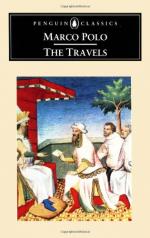“Eight days from thence is Middle India, which is Aden, and in Scripture Eden in Thelasar. This country is very mountainous, and contains many independent Jews who are not subject to the power of the Gentiles, but possess cities and fortresses on the summits of the mountains, from whence they descend into the country of Maatum, with which they are at war. Maatum, called also Nubia, is a Christian kingdom and the inhabitants are called Nubians,” etc. (p. 117). Here the Rabbi seems to transfer Aden to the west of the Red Sea (as Polo also seems to do in this chapter); for the Jews warring against Nubian Christians must be sought in the Falasha strongholds among the mountains of Abyssinia. His Middle India is therefore the same as Polo’s or nearly so. In Jordanus, as already mentioned, we have India Tertia, which combines some characters of Abyssinia and Zanjibar, but is distinguished from the Ethiopia of Prester John, which adjoins it.
But for the occurrence of the name in R. Benjamin I should have supposed the use of it to have been of European origin and current at most among Oriental Christians and Frank merchants. The European confusion of India and Ethiopia comes down from Virgil’s time, who brings the Nile from India. And Servius (4th century) commenting on a more ambiguous passage—
—“Sola
India nigrum
Fert ebenum,”
says explicitly “Indiam omnem plagam Aethiopiae accipimus.” Procopius brings the Nile into Egypt [Greek: ex Indon]; and the Ecclesiastical Historians Sozomen and Socrates (I take these citations, like the last, from Ludolf), in relating the conversion of the Abyssinians by Frumentius, speak of them only as of the [Greek: Indon ton endotero], “Interior Indians,” a phrase intended to imply remoter, but which might perhaps give rise to the term Middle India. Thus Cosmas says of China: “[Greek: aes endotero], there is no other country”; and Nicolo Conti calls the Chinese Interiores Indi, which Mr. Winter Jones misrenders “natives of Central India."[1] St. Epiphanius (end of 4th century) says India was formerly divided into nine kingdoms, viz., those of the (1) Alabastri, (2) Homeritae, (3) Azumiti, and Dulites, (4) Bugaei, (5) Taiani, (6) Isabeni, and so on, several of which are manifestly provinces subject to Abyssinia.[2] Roger Bacon speaks of the “Ethiopes de Nubia et ultimi illi qui vocantur Indi, propter approximationem ad Indiam.” The term India Minor is applied to some Ethiopic region in a letter which Matthew Paris gives under 1237. And this confusion which prevailed more or less till the 16th century was at the bottom of that other confusion, whatever be its exact history, between Prester John in remote Asia, and Prester John in Abyssinia. In fact the narrative by Damian de Goes of the Embassy from the King of Abyssinia to Portugal in 1513, which was printed at Antwerp in 1532, bears the title “Legatio Magni Indorum Imperatoris,” etc. (Ludolf, Comment. p. 2 and 75-76; Epiph. de Gemmis, etc., p. 15; R. Bacon, Opus Majus, p. 148; Matt. Paris, p. 372.)




